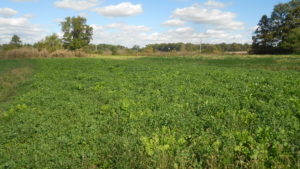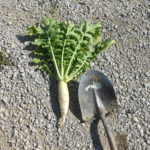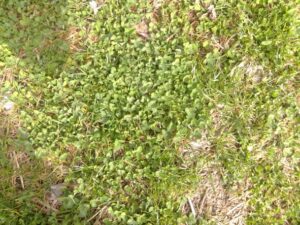By Gabe Ross, Farm Manager

This August at Gallant Farm we planted a few fields with cover crops. While the term “cover crop” is new, the idea isn’t: During the 1930s the term used for a cover crop was green manure. Farmers from around the world have used green manures for centuries, dating back to Ancient China and the Roman Empire. These crops – planted in the fallow season when there is no cash crop – help control erosion and nutrient runoff, scavenge nutrients, fix nitrogen, smother weeds, and add organic matter to the soil. On many small farms in the 1930s, hay crops such as grasses, clover and alfalfa were part of a crop rotation with corn, wheat and oats. These hay crops were not only used for feed, they also held the soil in place while the legumes fixed nitrogen, decreasing the need for purchased nitrogen fertilizers.
We follow this rotation at Gallant Farm as well, but sometimes after the wheat is harvested in July we plant a cover crop in mid-August, usually consisting of peas and radish. The radish we use is a type of Daikon radish called ground hog. These radishes weren’t used in the 1930s, but they have some great benefits to the soil and provide a teaching opportunity.

Ground hog radishes were bred specifically as a cover crop, not for eating. They get very big – often 8 to 10 inches – and have a tap root that goes much deeper. The plants will grow until they are eventually killed by frost; after that, they will rot in place. The long tap roots bring up nutrients from the subsoil and the holes left after they rot encourage drainage. The rotted radishes become part of the soil, and the peas planted along with them fix nitrogen. In spring the field will be tilled, mixing the remnants of the peas and radishes into the soil, and planted to corn.
Another cover crop we used this year was rye. Rye is a more traditional cover crop and helps smother weeds and break up tough soil in fields with weed problems. It will be tilled in the spring as well. Lots of work has been done recently with cover crops and many more farmers are using them, but they also have great benefits in the home garden. They can help build and maintain healthy soil and often decrease the need for chemical fertilizers and other expensive inputs. Visit Gallant Farm to see our cover crops and stay tuned in the Spring for a follow up on how the soil looks when everything is tilled in.








